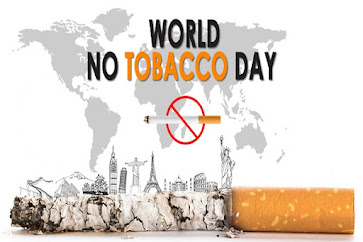31st May, 2023- World No Tobacco Day: “We need food, not tobacco”.
Tobacco Use is Leading Cause of Preventable Death
- Introduction and Overview
Tobacco kills up to half of its users. Tobacco kills more than 8 million people each year. More
than 7 million of those deaths are the result of direct tobacco use while around 1.2 million are the
result of non-smokers being exposed to secondhand smoke. Over 80% of the world's 1.3 billion
tobacco users live in low- and middle-income countries. In 2020, 22.3% of the global population
used tobacco, 36.7% of all men and 7.8% of the world’s women. To address the tobacco epidemic,
WHO Member States adopted the WHO Framework Convention on Tobacco Control (WHO FCTC)
in 2003. Currently 182 countries have ratified this treaty. The WHO MPOWER measures are in line
with the WHO FCTC and have been shown to save lives and reduce costs from averted healthcare
expenditure.
Tobacco use is leading cause of preventable death. This global tobacco epidemic kills more
people than tuberculosis, HIV/AIDS and malaria combined. According to the World Health
Organization (WHO) estimates, globally, there were 100 million premature deaths due to tobacco
in the 20th century, and if the current trends of tobacco use continue, this number is expected to
rise to 1 billion in the 21st century.
“Tobacco products” means products entirely or partly made of the leaf tobacco as raw material
which are manufactured to be used for smoking, sucking, chewing or snuffing”. Tobacco use is a
major risk factor for many chronic diseases, including cancer, lung disease, cardiovascular
disease and stroke. Globally, tobacco use is one of the biggest public health threats. It leads not
only to loss of lives but also has heavy social and economic costs.
India is the second largest consumer of tobacco globally, and accounts for approximately
one-sixth of the world’s tobacco-related deaths. The tobacco problem in India is peculiar, with
consumption of variety of smokeless and smoking forms. Many of these products are
manufactured as cottage and small-scale industries using varying mixtures and widely differing
processes of manufacturing Understanding the tobacco problem in India, focusing more efforts
on what works and investigating the impact of sociocultural diversity and cost-effectiveness of
various modalities of tobacco control should be our priority.
In India, beedi smoking is the most popular form of tobacco smoking. Cigarette smoking is the
second most popular form of tobacco smoking. Paan with tobacco is the major chewing form of
tobacco. Dry tobacco areca nut preparations such as paan masala, gutka and mawa are also
popular and highly addictive. Tobacco dentifrice is popular, especially in some areas, and children
also use it.
- Epidemiology
Nearly 275 million adults (15 years and above) in India (35% of all adults) are users of tobacco,
according to the Global Adult Tobacco Survey India, 2016-17. The most prevalent form of tobacco
use in India is smokeless tobacco and commonly used products are khaini, gutkha, betel quid
with tobacco and zarda.
In India, This figure is made up of 164 million smokeless tobacco users, 69 million smokers, and
42 million people using both smoking and smokeless forms of tobacco. In India, 53.9 million men
and 11.1 million women, 48.6 million of rural population and 16.5 million of urban population
consume gutkha. The dependency on tobacco and damage of health due to gutkha consumption
is recognized as a life threatening disorder with the health consequences. The increased use of
gutkha has led to the highest incidence of oral cancer in India.
- Health hazards
- Secondhand Smoke Exposure
Based on the scientific evidence, the Conference of the Parties to the WHO Framework
Convention of Tobacco Control (WHO FCTC) has concluded that 100% smoke-free environments
are the only proven way to adequately protect the health of people from the harmful effects of
second-hand tobacco smoke. Smoke-free laws protect the health of non-smokers and are popular,
as they do not harm business and they encourage smokers to quit.
Today, about half of all children between ages 3 and 18 years in this country are exposed to
cigarette smoke regularly, either at home or in places such as restaurants that still allow smoking.
Compared to children who are not exposed, children exposed to secondhand smoke.
- Youth and Smoking
- Smokeless Tobacco
The oral use of smokeless tobacco is widely prevalent in India; the different methods of
consumption include chewing, sucking and applying tobacco preparations to the teeth and gums.
Smokeless tobacco products are often made at home but are also manufactured. Recently, a
variety of smokeless tobacco products have been produced industrially on a large scale,
commercially marketed and are available in small plastic and aluminium foil packets. the use of
smokeless tobacco, including gutkha, is a prevalent and dangerous practice that poses serious
health risks, especially for oral cancer. Despite being banned by Indian states since 2012, gutkha
remains widely used and available. Gutkha is a mixture of areca nuts, slaked lime, catechu,
tobacco, added flavourings, and sweeteners.
- Youth and Smokeless Tobacco Gutkha
- Ecological and Environmental Effects of Tobacco Use
Tobacco requires huge chemical inputs. Such chemicals may run off into water bodies,
contaminating local water supplies. High levels of pesticide use may also lead to the
development of resistance in mosquitoes and flies. Frequent contact with and spraying of
chemicals, and storage of tobacco in residential premises of farmers have adverse health effects.
Tobacco is heavily dependent on fertilizers. With increased irrigation, mistimed fertilizer
application causes excessive leaching, including that of nitrogen and potassium. In India, an
estimated 20,000 children work in tobacco farms and another 27,000 work in beedi-making or
packing cigarettes.
Cigarette butts and other tobacco product wastes(TPW) are the most common items picked up in
urban and beach cleanups worldwide. TPW contains all the toxins, nicotine, and carcinogens
found in tobacco products, along with the plastic non biodegradable filter attached to almost all
cigarettes sold in the most countries worldwide. Toxicity studies suggest that compounds
leached from cigarette butts in salt and fresh water are toxic to aquatic micro-organisms and test
fish. Toxic chemicals have also been identified in roadside TPW. With as much as two-thirds of all
smoked cigarettes (numbering in the trillions globally) being discarded into the environment each
year, it is critical to consider the potential toxicity and remediation of these waste products.
- Prevention and Cessation
Public health awareness, raising a mass movement against tobacco, sensitizing and educating all
health care professionals for tobacco control and cessation by incorporating the topic in medical
undergraduate curriculum, nursing curriculum, various CMEs, conferences, scientific meetings,
workshops, etc. is vital.
Quitting tobacco: When tobacco users become aware of the dangers of tobacco, most want to
quit. However, nicotine contained on tobacco products is highly addictive and without cessation
support only 4% of users who attempt to quit tobacco use will succeed. Professional support and
proven cessation medications can more than double a tobacco user's chance of successful
quitting.
- Conclusion
Smoking: All forms of tobacco are harmful, and there is no safe level of exposure to tobacco.
Cigarette smoking is the most common form of tobacco use worldwide. Other tobacco products
include waterpipe tobacco, various smokeless tobacco products, cigars, cigarillos, roll-your-own
tobacco, pipe tobacco, bidis and kreteks.
- Key Message
- Warn about the dangers of tobacco.
- Raise taxes on tobacco.
- Enforce bans on tobacco advertising, promotion and sponsorship.
- Monitor tobacco use and prevention policies.
- Protect people from tobacco use.
- Offer help to quit tobacco use.
- References
- Report on Tobacco Control in India (New Delhi, India), In: Reddy KS, Gupta PC, Editors, New Delhi, India: Ministry of Health and Family Welfare; 2004.
- Jha P, Jacob B, Gajalakshmi V, Gupta PC, Dhingra N, Kumar R, et al. A nationally representative case–control study of smoking and death in India. N Engl J Med 2008;358:1137-47.
- A global epidemic of addiction and disease. Tobacco: deadly in any form or disguise. World Health Organization. WHO Tobacco Free Initiative. ISBN 92 4 156322 2 (NLM classification: QV 137) ISBN 978 92 4 156322 World No Tobacco Day 2006.
- WHO Report on The Global Tobacco Epidemic, 2011. The MPOWER package, warning about the dangers of tobacco. Geneva: WHO; 2011.
- An overview of the tobacco problem in India. Gauravi A. Mishra, Sharmila A. Pimple, Surendra S. Shastri Indian Journal of Medical and Paediatric Oncology | Jul-Sep 2012.
- WHO World No Tobacco Day 2023.
Regards and Thanks
Dr. (Prof)Rajendra T. Nanavare
Chest Physician and
Ex Medical Superintendent GTB hospital Sewri Mumbai.





Thank you for knowledge sharing efforts doctor!
ReplyDeleteतंबाखू आणि अल्कोहोल हे हानिकारक आहे हे सर्वांना ज्ञात आहे. अंमली पदार्थांचे सेवन है धोकादायक असताना देखील त्याचे आहारी म्हंजे मुर्खाचे लक्षण होय. आणि त्यास परवानगी आणि प्रसिध्दी देणारे सरकार महा मूर्ख. तरी याला बळी पडणारे रुग्ण यांना आपण नुसते बरे करत नाही तर त्यास व्यसनमुक्त करत आहात म्हणून आपले व आपल्या सारखे इतर डॉक्टर यांचे खूप खूप आभार. खूप छान लेख लिहला आहे. नवीन डॉक्टर यांना छान study material असेल.
ReplyDeleteSuperb ...explained aptly and quite informative...publishing such article on regular basis would vide difference means discourage youths on usage of tobacco.
ReplyDeleteSuperb ...explained aptly and quite informative...publishing such article on regular basis vide different means would discourage youths on usage of tobacco
ReplyDeleteExcellent in depth and and very informative article. Keep doing the good work. Thank you
ReplyDeleteWell written & informative..
ReplyDeleteThank you so much everyone, for your thoughtful appreciation.
ReplyDelete